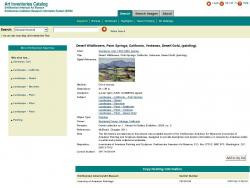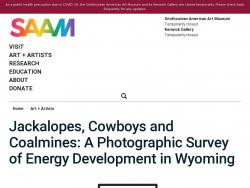Kate Harris
Social Studies teacher
Pittsburgh CAPA
Middle School (13 to 15 years old), High School (16 to 18 years old)
Teacher/Educator
Language Arts And English, Civics, Literature, Cultures, Economics, Social Studies, Geography, Writing, US History, Arts, Other
I'm a history-lover, art fan, and bookworm. I taught high school history (U.S. History and World Religions) for ten years in North Carolina, teach currently in Pittsburgh, PA, and am working to help teachers make the most of this new resource!
Kate Harris's collections
Robber-Baron or Captain of Industry: Andrew Carnegie
<p>This collection includes different perspectives and information about Andrew Carnegie. Students are challenged to build an argument supporting one position or the other: Robber-Baron or Captain of Industry--using the resources as evidence. <strong>Was Carnegie an industrialist who desired to get rich and promote himself regardless of the effects on his workers? Or was he an example of the American dream, an industrial leader who improved the nation and helped its people?</strong></p>
<p>Investigate the items in this collection while thinking about those questions. After an initial review of the collection, complete the sorting activities at the end to test your understanding of the issue and begin to develop an argument reflecting your answer to the question above. </p>
 Kate Harris
Kate Harris
19
Carlisle Indian Industrial School
<p>Perhaps the most famous of the Indian boarding schools created in the late 19th century, the Carlisle Indian Industrial School in Pennsylvania was founded by Captain Richard Henry Pratt (with funding and support from the United States government), with the purpose of assimilating (or Americanizing) Indian students. </p><p>Student will use archival materials to explore student life at Carlisle Indian School and to evaluate assimilation policy as practiced through the school. <strong>What was gained and lost through the process of assimilation? </strong></p><p>Using these resources as a starting point, users should research one former Indian student or one aspect of student life using the <a href="http://carlisleindian.dickinson.edu/" target="_blank">Carlisle Indian School Digital Resource Center</a>. Many student files record not only experiences that occurred while at the school, but information about occupations and life after the boarding school experience. Were students and families able to shape positive experiences despite the intended consequences of boarding school policy? </p><p><span>Students should create a writing or artwork that reflects information learned about that particular student or activity and that shares the learner's opinions on assimilation policy and the response of Native Ameri</span><span>cans</span><span>. </span><strong>How should the Carlisle Indian School be remembered? </strong></p><p>Tags: Native American, Indian, boarding school, assimilation, Pratt, Dawes Act, Jim Thorpe, allotment</p>
 Kate Harris
Kate Harris
32
Quilt Quest
<p>Did you know that quilts are also historical artifacts? Use this collection to learn more about how curators investigate quilts to learn about their origins, and then explore a variety of different quilts that tell us important things about the time in which they were made and the crafters who made them. Finally, make your own quilt depicting an important historical moment. </p><p>tags: quilt, craft, activity, review</p>
 Kate Harris
Kate Harris
19
Cold War Fears
<p>This is a topical collection about American fears during the Cold War. What were Americans afraid of? How were these fears expressed in United States culture? How successfully did the government address these fears?</p><p><br /><br /></p><p>Students and teachers may want to explore the resources in this collection to consider the psychological impact of the Cold War and how Americans prepared themselves for the unknown. </p><p><br /><br /></p><p>Tags: Cold War, McCarthy, UFOs, aliens, space race, fallout shelters, Civil Defense, radiation, spies, Hiss, Rosenberg, Murrow, Sputnik, cause and effect</p>
 Kate Harris
Kate Harris
15
Who provoked the Korean War?
"On June 25, 1990, the North Korean Army launches it surprise assault on the South." But what led up to this moment? This activity asks students to read primary source documents and interpret historical events surrounding the Korean conflict. Students will look for motives and evidence in a variety of accounts and determine who was responsible for starting the Korean War. <br />
<br />
There are resources with quiz questions that students can answer directly, or teachers may prefer to print documents and resources for in-class use. It is recommended that teachers preview the materials in this teaching collection as there are a variety of ways to structure the lesson.<br />
<br />
Essential questions include:<br />
-How would you describe the relationship between Kim Il Sung and Joseph Stalin?<br />
-Was North Korea, a smaller country, pulling a superpower into a conflict?<br />
-Was the Soviet Union using North Korea to further its goals?<br />
-Why did the United States choose to respond via the United Nations forces instead of unilaterally? How did this decision impact the conflict?<br />
-How does this incident reflect larger themes and issues of the Cold War, especially the role of the United Nations, over-arching foreign policy strategy, and nuclear fears?<br />
<br />
Tags: Wilson Center, Cold War, Korea, China, Truman, Eisenhower, Macarthur, Soviet Union, USSR, Communism
 Kate Harris
Kate Harris
17
Origin Stories from Around the World
<p> Creation myths, or origin stories, tell us what a culture believes about how humans came to be. They can also tell us much about what that culture values. These are often religious or spiritual explanations for human life. </p><p>Choose one of origin stories on this page to focus on. Read, watch, or listen to the story. Then, create a visual that illustrates a scene in the story that you think is revealing about that culture's values. Finally, write a paragraph summarizing what you learned about that culture based on their origin story.</p><p>To recap:</p><p>1. Read/watch listen.</p><p>2. Create a visual of 1 scene in the story. </p><p>3. Write a paragraph summarizing what you learned about that culture based on their origin story. <br /></p>
 Kate Harris
Kate Harris
8
3D Technology and Repatriation of the Kéet-S’aaxw
<p>This student activity introduces students to the concept of repatriation of cultural heritage items to the tribes to whom they belong, and the ways that museums and Native American groups are now using 3D technology to aid in the process. A killer whale hat, or kéet-s'aaxw, was requested to be repatriated by members of the Tlingit tribe. The Smithsonian Institution, under the repatriation provisions of the National Museum of the American Indian Act, did so. In the years following, the clan's leader decided that it might be beneficial to 3D scan the image in order to preserve its details and protect it in case of loss or fire. Having this data allowed the museum to create an accurate replica to be used for educational purposes, and provided the tribe with peace of mind. Learn more about this story and other cases of repatriation and replication in this collection which includes a 3D model and tour, video, website, and images of objects that have been part of the process. </p>
<p>Essential Questions include:</p>
<ul><li>How does the current process of repatriation reflect a change in traditional relationships between museums and indigenous groups?</li><li>What kinds of guidelines should be used to determine which objects should be repatriated?</li><li>What benefits does 3D technology provide for museums and Native American tribes? Can you envision other scenarios where 3D technology might play a similarly beneficial role?</li></ul><p>Tags: Native American, American Indian, Tlingit, repatriation, replication, 3D technology, whale hat, indigenous, rights, change over time, museums, anthropology</p>
 Kate Harris
Kate Harris
10
Rachel Carson: Innovator
<p>In what ways was Rachel Carson an innovator? She diligently pursued her goals as a female scientist and author and sparked the environmental movement with her book "Silent Spring." As you look through this collection, consider the characteristics of innovators. What innovative characteristics do you share with her?</p>
<p>For more on the characteristics that make up an innovator, look at the Heinz History Center website. You can even take a quiz and find out what innovator you are most like:</p>
<p><a href="http://www.heinzhistorycenter.org/education/school-programs-k-12/steam/innovator-mtch-up">http://www.heinzhistorycenter.org/education/school...</a></p>
<p>tags: Pittsburgh, science, environment,Silent Spring, Chatham, Maine, Fish and Wildlife Service, #BecauseOfHerStory</p>
 Kate Harris
Kate Harris
15
Who is Frances Mary Albrier?
<p>This is a collection of items belonging to, or about, Frances M. Albrier. Although an important female leader and activist during the mid-20th century, many students may not have heard of Ms. Albrier. Encourage students to act as history detectives, exploring the collection to determine why this woman's belongings are in the collections of the Smithsonian.</p>
<p>Some questions to consider:</p>
<ul><li>What are Albrier's main accomplishments? What types of occupations did she have?</li><li> Based on these, what values do you think were important to her?</li><li>How does Albrier's life reflect major changes for women during the 20th century? Changes for African-Americans?</li><li>What do these items tell us about challenges facing African-American women in the mid-century?</li><li>What remains unknown about Albrier based on this collection? Where else could you go to look for more information?</li><li>Look at an encyclopedia entry for Ms. Albrier. Are there any events mentioned not covered in this collection? What might be a good item to add in order to better show her life?</li></ul><p><br /></p>
<p>tags: activism, civil rights, union, labor, voter registration, 60s, world war II, shipyards, WW2, nursing, Red Cross, National Council of Negro Women, Nigeria, independence, peace, moral rearmament, #BecauseOfHerStory</p>
 Kate Harris
Kate Harris
15
Native American Policy Overview
<p>During the late 19th century, reformers in the United States like Helen Hunt Jackson pushed for a change in attitude towards Native Americans. Rather than simply viewing them as enemies from whom land could be gained, these reformers promoted the concept of assimilation, or helping Native Americans adopt the characteristics of white culture that would allow them to be successful in American society. One of the ways they did this was through the use of Christian boarding schools for Native American children. Federal laws, like the Dawes Act of 1887, also supported this goal. </p>
<p>As you investigate the artifacts, images, and readings in this collection, consider whether you think assimilation was a beneficial policy for Native Americans. How did Native American families respond to assimilation?</p>
<p>Tags: point of view, assimilation, assimilate, American Indians, Carlisle, Jim Thorpe, allotment</p>
 Kate Harris
Kate Harris
14
"Let Women Fly!": Female Aviators and Astronauts
<p>Did you know that astronaut Mae Jemison carried a picture of aviator Bessie Coleman in her uniform pocket? Or that astronaut Sally Ride was a major supporter of vice presidential candidate Geraldine Ferraro? Maybe you knew that Jane Briggs Hart was Michigan's first female helicopter pilot and flew her husband, the late Senator Hart, to his political campaign stops as well as being vocal and liberal political activist? Find out about these inspirational women and others in this collection. This topical collection is a great starting point for research about female aviators and astronauts, and includes articles, images, artifacts, and video. Some guiding questions to consider might be:<br />-Why do you think it was so challenging for female pilots to become accepted? Compare the inclusion of women in aviation to other industries and fields. <br />-What role did the military play in the growth in the number of female aviators?<br />-What connections can you find between various female pilots and astronauts?<br />-Is being the "first" of something a political act? How do many female aviation leaders use their public voice?</p><p>#BecauseOfHerStory<br /></p>
 Kate Harris
Kate Harris
48
Wounded Knee, Past and Present
<p>Wounded Knee is often portrayed as the closing point of the wars between Native Americans and the United States government in the late 19th century. However, the place also marks a moment of historic protest. This collection can be used to explore the importance of place in protest movements as well as the history of violence and resistance for indigenous people in the United States. </p><ul><li>How should the site of Wounded Knee be remembered?</li><li>Why did the activists choose to occupy Wounded Knee? What is the significance of that place?</li><li>How were the actions of the American Indian Movement activists similar or different to their ancestors? Consider motives, strategies, and successes, and partnerships.</li></ul><div>tags: Sitting Bull, Oglala, Sioux, Lakota, occupation, massacre, DAPL, Dakota Access, Red Cloud, Kicking Bear, Ghost Dance, cavalry</div>
 Kate Harris
Kate Harris
9









